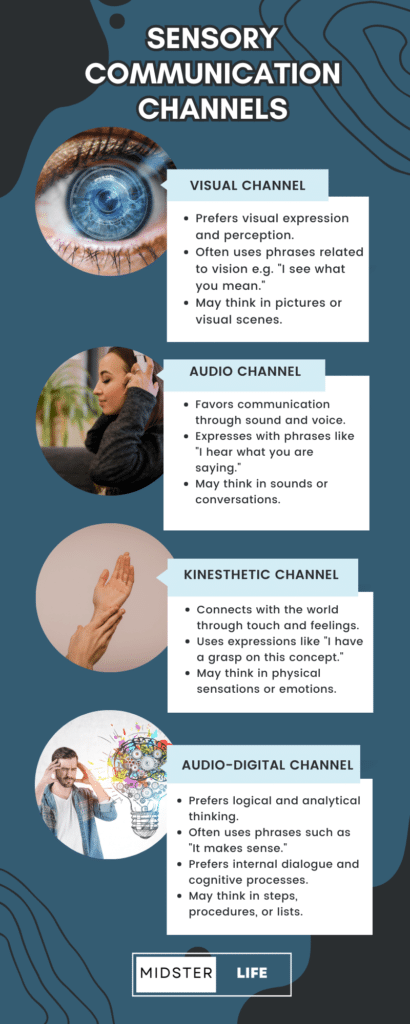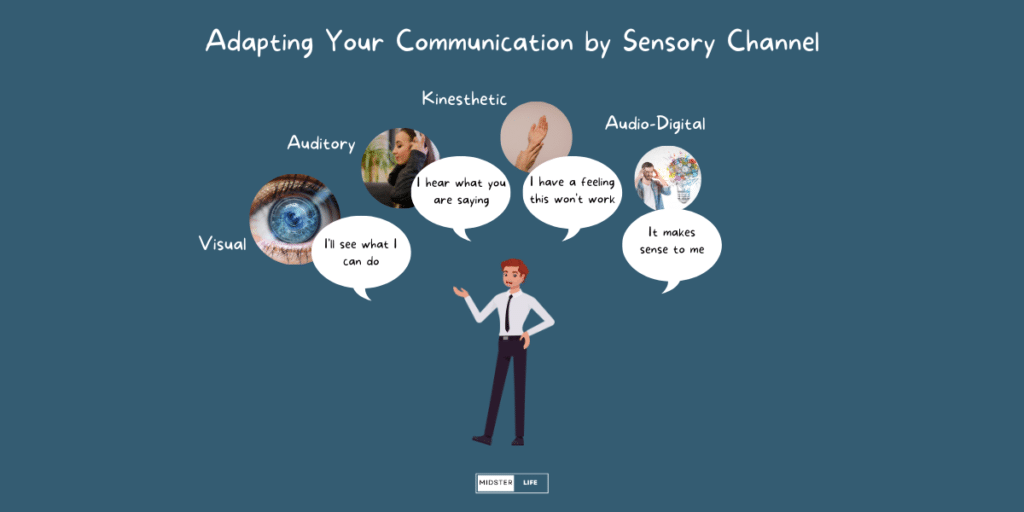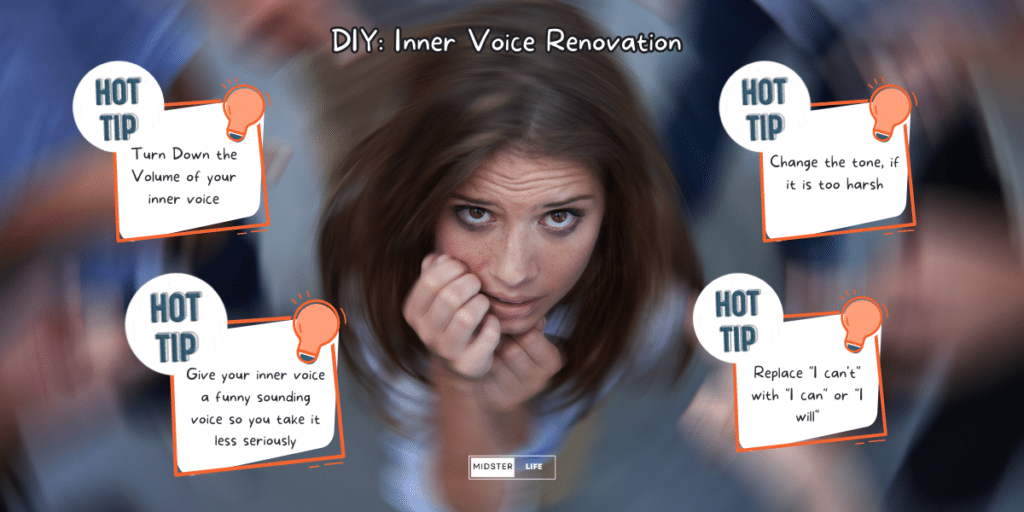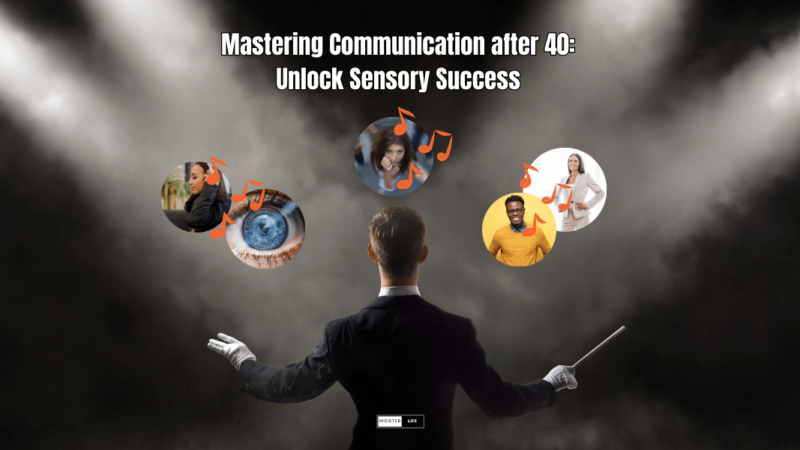Master Communication After 40: Unlock Sensory Success
Do you remember when you first heard your favorite song and could almost see the melody or when a comforting touch spoke volumes? Our senses play a significant role in how we perceive and interact with the world. But did you know they can also be your secret weapon in mastering communication after 40 and beyond? This blog post will explore the fascinating world of sensory channels and their impact on our interactions. So let’s get tuned into the rhythm of more effective and vibrant communication.
Sensory Success for Effective Communication After 40

Everyone perceives the world differently and has a unique mode of expression and understanding, often linked to a preferred sensory channel. This tendency plays a crucial role in shaping our communication styles.
Visual Channel
Preferred by people who express and perceive information visually. People with a visual preference frequently use phrases like “I see what you mean,” “It’s clear that,” or “I’ll see what I can do,” employing words that relate to vision.
Auditory Channel
Preferred by individuals that are more tuned to sound and voice. Those favoring an auditory channel may express themselves with phrases such as “I hear what you are saying” reflecting their inclination toward sound.
Kinesthetic Channel
Dominant for those who connect with the world through touch and feelings. The kinesthetic communicators are the feelers and touchers, using expressions like “I have a feeling this will not work,” “Do you grasp this concept?” or “I’m super excited to work with you.”
Auditory-Digital Channel
Lastly, auditory-digital communicators are logical, analytical thinkers, frequently using phrases like “It makes sense,” “I understand,” or “Let’s analyze.” These individuals often demonstrate a preference for internal dialogue and cognitive processes.

Recognizing these diverse communication styles allows you to tailor your language and approach to match the needs of your conversational partner. This ability can significantly enhance the quality of your connections, fostering more robust relationships.
For instance, you can adapt your language based on these preferences. If you’re dealing with a visual communicator, instead of using an auditory phrase like “I hear what you are saying,” you might say, “I see what you mean,” or “This solution looks to be the best.” You can communicate more effectively and build stronger relationships by paying attention to and aligning with others’ preferred sensory channels.
The Role of Our Physiology in Communication After 40

One factor in communication that’s vital but often overlooked – is our bodies and minds. Research by Amy Cuddy showed that striking power poses can positively impact mood and well-being. So, have you ever stopped to think about how deeply our physicality influences our emotional well-being?
To bring this to life, imagine this scenario. You’re at a coffee shop. Across the room, someone is hunched over, eyes downcast, shoulders slumped, and breathing shallow. What do you think they’re feeling? Not exactly the life of the party, right? The peculiar thing is, you can almost feel their sadness, can’t you? Funny how our body language tells our stories, even when we’d prefer them to stay secret.
Your physiology, posture, how you move, and even how you breathe are not just a mirror for your emotions; they can actually stir them up! A downcast gaze and slouched posture can make us feel low, even without apparent reason.
The great news is it works both ways! If you consciously strike a pose of confidence, that big smile, chin up, shoulders back, and breathing easy, you’ll feel an uptick in your mood.
Your internal voice

The next element to consider is the role of minds and internal voice. You know that voice inside your head? The one that never takes a coffee break. How does it sound to you? Friendly, supportive, and understanding, like an old mate? Or is it more like a grumpy uncle who’s forgotten his spectacles?
Suppose you are stuck in a lift with someone for the rest of your life. Wouldn’t you want to get along with them? That’s exactly how it is with your inner voice. Whether you like it or not, you’re in there together, so you might as well make it a positive partnership.
But how? Well, here’s where we play sound engineer with that inner voice:
- Turn down the volume if it’s too loud.
- Change the tone if it’s too harsh.
- Replace those “I can’t” with an “I can!” or “I will.”
Think of it as a DIY inner voice renovation. And It’s easier than building flat-pack furniture.
Communication is about more than just talking to others. It’s about talking to ourselves too. And remember, a little kindness goes a long way, even if directed inward.
Mastering Communication After 40
Mastering effective communication isn’t limited to expressing our thoughts and feelings to others; it also involves understanding ourselves and harnessing our preferred sensory channels.
As we progress in our life journey, embracing the potency of our sensory channels, the impact of our physiology and the power of our internal voice is vital to thriving in our interactions.
The fantastic revelation is that you can adapt and cultivate these tools right at your fingertips! It’s a dynamic process, an opportunity to tune in, resonate, and harmonize with the world around us.
So, let’s engage in this wonderful symphony of communication, explore our sensory orchestra, and celebrate the beautiful connections we can create. Here’s to vibrant communication and stronger relationships in our 40s and beyond!


